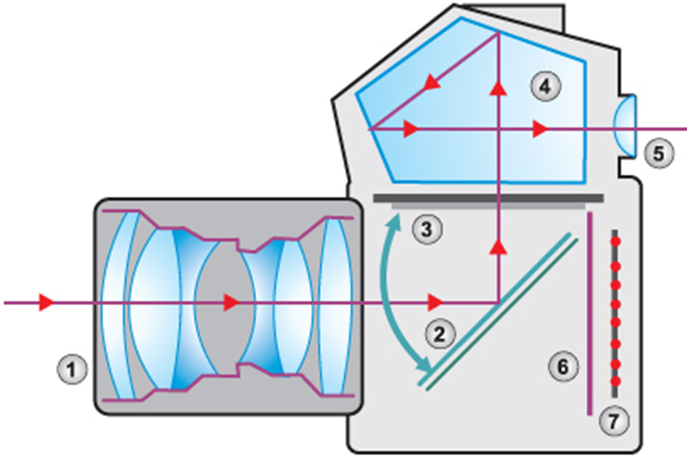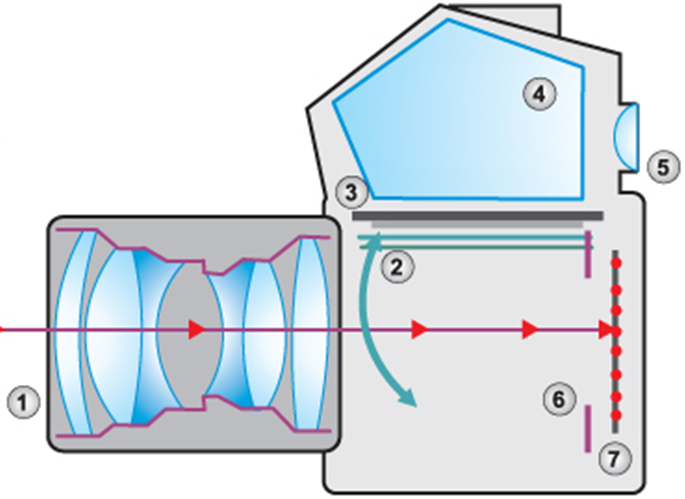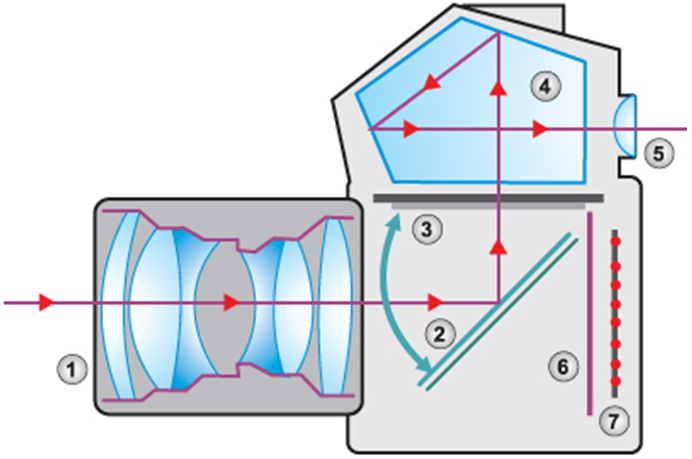In this post we will talk about the basic principles of a DSLR camera’s mechanism. After reading this post you will have necessary knowledge to understand the lessons that will follow shortly.
What is a DSLR camera anyway? The abbreviation stands for “Digital Single Lens Reflex” camera. So that is a digital camera which uses a single lens, and has a mirror which is reflecting the light that enters the camera body through the lens. Let’s get into more details.
A camera body contains several important parts, and we will explain them as we follow the path of the light that enters the camera body through the lens opening:

When the light passes the lens (1), it hits the mirror (2) and reflects upward. It’s passing the matte focusing screen (3) and enters the pentaprism (4). In the pentaprism the light reflects two times and then exits through the viewfinder, allowing the photographer to see the scene and create the composition.
When the photographer presses the shutter release button, several things happen:

A mirror (2) rises and allows the light to pass through. The light is not reflected up anymore and this is the reason why you see a short “blackout” in the viewfinder when you press the button. The light continues further toward the shutter curtains (6). The first (lower) curtain starts moving down, thus allowing the light to reach the sensor (7). The upper curtain follows down and stops the light. Finally, all the elements (the mirror and the curtains) go back to their initial position.
There are some important terms that you should remember in order to follow the following posts.
- Focal length is the distance between the lens’ focal point and the sensor. It is expressed in milimeters. There are prime and zoom lenses. The prime lenses have fixed focal length, e.g. 35mm, 50mm, 85mm, 105mm… The zoom lenses have different ranges of focal lengths, e.g. 18-55mm, 18-105mm, 24-70mm, 70-200mm, and so on.
- Aperture is the measure of the lens opening. It is expressed as a fraction f/X, where “f” is the focal length and X is its divisor, for example f/1.8, f/2, f/3.6, f/11… Of course, the smaller the number, the wider the lens opening and vice versa. There are zoom lenses with fixed maximum aperture. For example, 70-200mm f/4 has a constant f/4 aperture throughout the whole zoom range. On the other hand, some lenses have variable maximum aperture. For example, 18-55mm f/3.5-5.6 has an f/3.5 aperture on its “wide” end (18mm), and when zooming in it decreases gradually to f/5.6 at its “tele” end (55mm).
- Shutter speed is a little bit misleding term. It is actually the duration of how long the shutter curtains remain open i.e. how long will the sensor be exposed to the light. It is expressed in seconds, or fractions of second, e.g. 1/1000s, 1/200s, 1/5s, 1s, 2s, 20s…
- ISO is the measure of the sensor’s sensitivity, e.g. ISO 100, 200, 400, 800, 1600, 3200… Lower number means that the sensor will have lower sensitivity, the image will be darker, but with less noise.
Focal length and aperture are the characteristics of a lens. Shutter speed and ISO are the characteristics of a camera. We will go over them one more time in the next lessons and we will also introduce some new terms, but this should be enough for the beginning.
See you soon with new posts. Until then, feel free to leave a comment and to share this post. Thank you for reading 🙂


Pingback: Exposure Triangle – Vladimir Tomić Photography